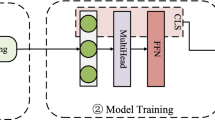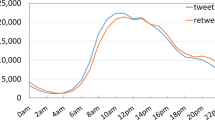Abstract
Due to the fast growing amount of user generated content (UGC) on social networks, the prediction of retweeting behavior is attracting significant attention in recent years. However, the existing studies tend to ignore the influence of implicit social influence and group retweeting factor factors. Also, it is still challenging to consider all related factors into a unified framework. To solve the above disadvantages, we propose a novel deep neural network fusion embedding-based deep neural network (FEBDNN) through the perspective of user embedding and tweets embedding for the author and the user’s historical tweets. Firstly, we propose dual auto-encoder (DAE) network for user embedding by integrating user’s basic features, explicit and implicit social influence and group retweeting factor. Then, we utilize the attention-based F_BLSTM_CNN(A_F_BLSTM_CNN) model for historical tweets’ representative embedding based on the combination of convolutional neural network (CNN) and bidirectional long short-term memory (BLSTM). Finally, we concatenate these embedding features into a vector and design a hidden layer and a fully connected softmax layer to predict the retweeting label. The experimental results demonstrate that the FEBDNN model compares favorably performance against the state-of-the-art methods.










Similar content being viewed by others
Explore related subjects
Discover the latest articles and news from researchers in related subjects, suggested using machine learning.References
Narwal R, Aggarwal H (2022) Predicting online game-addicted behaviour with sentiment analysis using twitter data[M]. In: Machine learning, advances in computing, renewable energy and communication. Springer, Singapore, pp 505–517
Sang CY, Liao SG (2020) Modeling and simulation of information dissemination model considering user’s awareness behavior in mobile social networks[J]. Physica A 537:122639
Kim J, Bae J, Hastak M (2018) Emergency information diffusion on online social media during storm Cindy in US[J]. Int J Inf Manage 40:153–165
Liu C, Zhou N, Zhan XX et al (2020) Markov-based solution for information diffusion on adaptive social networks[J]. Appl Math Comput 380:125286
Neubaum G, Krämer NC (2017) Monitoring the opinion of the crowd: Psychological mechanisms underlying public opinion perceptions on social media[J]. Media Psychol 20(3):502–531
Zhou C, Bai J, Song J, et al (2018) Atrank: an attention-based user behavior modeling framework for recommendation[C]. In: Proceedings of the AAAI Conference on Artificial Intelligence 32(1)
Karidi DP, Stavrakas Y, Vassiliou Y (2018) Tweet and followee personalized recommendations based on knowledge graphs[J]. J Ambient Intell Humaniz Comput 9(6):2035–2049
Wang S, Li C, Wang Z et al (2020) BPF++: a unified factorization model for predicting retweet behaviors[J]. Inf Sci 515:218–232
Khan P I, Razzak I, Dengel A, et al (2021) Understanding information spreading mechanisms during COVID-19 pandemic by analyzing the impact of tweet text and user features for retweet prediction[J]. arXiv preprint. arXiv:2106.07344
Ameur H, Jamoussi S, Hamadou AB (2019) A deep neural network model for predicting user behavior on facebook[C]. In: 2019 International Joint Conference on Neural Networks (IJCNN). IEEE, pp 1–8
Zhang Q, Gong Y, Guo Y, et al (2015) Retweet behavior prediction using hierarchical dirichlet process[C]. In: Proceedings of the AAAI Conference on Artificial Intelligence. 29(1)
Liu Z, Zhang D, Luo G et al (2020) A new method of emotional analysis based on CNN-BiLSTM hybrid neural network[J]. Clust Comput 23(4):2901–2913
Jiang B, Lu Z, Li N, et al (2018) Retweet prediction using social-aware probabilistic matrix factorization[C]. In: International conference on computational science. Springer, Cham, pp 316–327
Zhang J, Tang J, Li J et al (2015) Who influenced you? predicting retweet via social influence locality[J]. ACM Trans Knowl Discov Data (TKDD) 9(3):1–26
Petrovic S, Osborne M, Lavrenko V (2011) Rt to win! predicting message propagation in twitter[C]. In: Proceedings of the international AAAI conference on web and social media. 5(1)
Tang X, Miao Q, Quan Y et al (2015) Predicting individual retweet behavior by user similarity: a multi-task learning approach[J]. Knowl-Based Syst 89:681–688
Jiang B, Liang J, Sha Y, et al (2016) Retweeting behavior prediction based on one-class collaborative filtering in social networks[C]. In: Proceedings of the 39th international ACM SIGIR conference on research and development in information retrieval. pp 977–980
Liu Y, Zhao J, Xiao Y (2018) C-RBFNN: a user retweet behavior prediction method for hotspot topics based on improved RBF neural network[J]. Neurocomputing 275:733–746
Shaoqing W, Cuiping L, Zheng W et al (2019) Prediction of retweet behavior based on multiple trust relationships[J]. J Tsinghua Univ (Science and Technology) 59(4):270–275
Kushwaha AK, Kar AK, Ilavarasan PV(2021) Predicting retweet class using deep learning[J]. In: Trends in deep learning methodologies, pp 89–112
Dai T, Xiao Y, Liang X et al (2021) ICS-SVM: a user retweet prediction method for hot topics based on improved SVM[J]. Digit Commun Netw. https://doi.org/10.1016/j.dcan.2021.07.003
Xiao Y, Huang Z, Li Q et al (2022)Diffusion pixelation: a game diffusion model of rumor and anti-rumor inspired by image rest oration[J]. IEEE Trans Knowl Data Eng. https://doi.org/10.1109/TKDE.2022.3144310
Boyd D, Golder S, Lotan G (2010) Tweet, tweet, retweet: conversational aspects of retweeting on twitter[C]. In: 2010 43rd Hawaii international conference on system sciences. IEEE, pp 1–10
Spiro E, Irvine C, DuBois C, et al (2012) Waiting for a retweet: modeling waiting times in information propagation[C]. In: 2012 NIPS workshop of social networks and social media conference. http://snap.stanford.edu/social2012/papers/spiro-dubois-butts.pdf. Accessed. 2012, 12
Zhang J, Liu B, Tang J, et al (2013) Social influence locality for modeling retweeting behaviors[C]. In: Twenty-third international joint conference on artificial intelligence
Zhang J, Tang J, Zhong Y, et al (2017) Structinf: mining structural influence from social streams[C]. In: Proceedings of the AAAI Conference on Artificial Intelligence, 31(1)
Liu W, He M, Wang LH et al (2016) Research on microblog retweeting prediction based on user behavior features[J]. Chin J Comput 39(10):1992–2006
Shi J, Lai KK, Hu P et al (2017) Understanding and predicting individual retweeting behavior: receiver perspectives[J]. Appl Soft Comput 60:844–857
Rivadeneira L, Yang JB, López-Ibáñez M (2021) Predicting tweet impact using a novel evidential reasoning prediction method[J]. Expert Syst Appl 169:114400
Jia K, Zhang X (2019) Micro-blog retweeting prediction based on combined-features and random forest[C]. In: CCF conference on computer supported cooperative work and social computing. Springer, Singapore, pp 429–440
Ma R, Hu X, Zhang Q, et al (2020) Hot topic-aware retweet prediction with masked self-attentive model[C]. In: Proceedings of the 42nd international ACM SIGIR conference on research and development in information retrieval, pp 525–534
Yin H, Yang S, Song X, et al (2020) Deep fusion of multimodal features for social media retweet time prediction[J]. World Wide Web, pp 1–18
Firdaus SN, Ding C, Sadeghian A (2021) Retweet prediction based on topic, emotion and personality[J]. Online Soc Netw Media 25:100165
Wang J, Yang Y (2021) Tweet retweet prediction based on deep multitask learning[J]. Neural Process Lett. https://doi.org/10.1007/s11063-021-10642-3
Yuan N J, Zhong Y, Zhang F, et al (2016) Who will reply to/retweet this tweet? The dynamics of intimacy from online social interactions[C]. In: Proceedings of the Ninth ACM International Conference on Web Search and Data Mining, pp 3–12
Zhang Q, Gong Y, Wu J, et al (2016) Retweet prediction with attention-based deep neural network[C]. In: Proceedings of the 25th ACM international on conference on information and knowledge management, pp 75–84
Steinskog A, Therkelsen J, Gambäck B (2017) Twitter topic modeling by tweet aggregation[C]. In: Proceedings of the 21st Nordic conference on computational linguistics, pp 77–86
Ray A, Rajeswar S, Chaudhury S (2015) Text recognition using deep BLSTM networks[C]. In: 2015 eighth international conference on advances in pattern recognition (ICAPR). IEEE, 1–6
Peters M, Neumann M, Iyyer M, et al (2018) Deep contextualized word representations[C]. In: Proceedings of the 2018 Conference of the North American Chapter of the Association for Computational Linguistics: Human Language Technologies, Volume 1 (Long Papers)
Duchi JC, Hazan E, Singer Y (2011) Adaptive subgradient methods for online learning and stochastic optimization. J Mach Learn Res 12:2121–2159
Machuca CR, Gallardo C, Toasa RM (2021) Twitter sentiment analysis on coronavirus: machine learning approach[C]. J Phys 1828(1):012104
Yang C, Tang J, Sun M, et al (2019) Multi-scale information diffusion prediction with reinforced recurrent networks[C]. In: IJCAI, pp 4033–4039
Wang Z, Chen C, Li W (2018) A sequential neural information diffusion model with structure attention[C]. In: Proceedings of the 27th ACM International Conference on Information and Knowledge Management, pp 1795–1798
Hamilton W L, Ying R, Leskovec J (2017) Inductive representation learning on large graphs[C]. In: Proceedings of the 31st International Conference on Neural Information Processing Systems, pp 1025–1035
Wang L, Zhang Y, Hu K (2021) FEUI: Fusion Embedding for User Identification across social networks[J]. Appl Int. https://doi.org/10.1007/s10489-021-02716-5
Acknowledgements
This study is supported by Zhejiang Provincial Natural Science Foundation of China under Grant No. LY19F020022, China Knowledge Centre for Engineering Sciences and Technology (CKCEST), Joint Funds of the Zhejiang Provincial Natural Science Foundation of China under Grant No. LHY21E090004.
Author information
Authors and Affiliations
Corresponding author
Ethics declarations
Conflict of interest
The authors declare that they have no conflict of interest.
Additional information
Publisher's Note
Springer Nature remains neutral with regard to jurisdictional claims in published maps and institutional affiliations.
Rights and permissions
About this article
Cite this article
Wang, L., Zhang, Y., Yuan, J. et al. FEBDNN: fusion embedding-based deep neural network for user retweeting behavior prediction on social networks. Neural Comput & Applic 34, 13219–13235 (2022). https://doi.org/10.1007/s00521-022-07174-9
Received:
Accepted:
Published:
Issue Date:
DOI: https://doi.org/10.1007/s00521-022-07174-9




